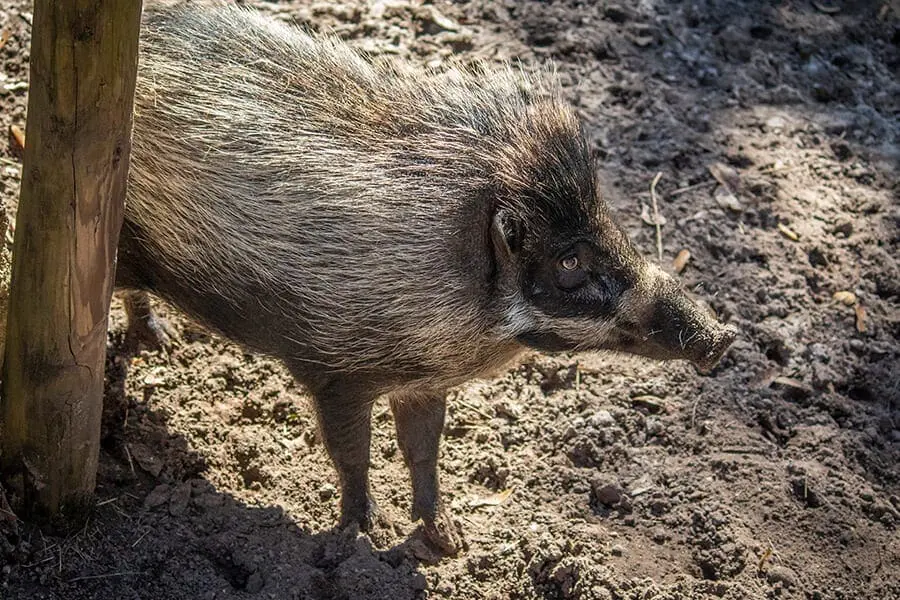

Occupying just a fraction of its historic range, the Visayan warty pig is considered critically endangered.
We are proud to provide a safe haven to numerous endangered species here at the Zoo. In celebration of Endangered Species Day, we’re giving you a closer look at some of the threatened animals that call the Zoo home.
BLUE-THROATED MACAW
These colorful birds hail from Bolivia, reaching around three feet in height. It is their stunning plumage that has led to the blue-throated macaw’s demise; they are heavily threatened by the pet trade. American Bird Conservancy—an organization we’ve worked with to protect songbirds in our backyard—is dedicated to increasing the population of this endangered species by supporting the creation and maintenance of nature reserves in Bolivia.
VISAYAN WARTY PIG
These mohawk-donning pigs were at one time found on six islands in the Philippines. Today, they remain on just two or three of those islands. Threatened by habitat loss, human hunting and hybridization with domestic pigs, we’re lending these wild hogs a much-needed hoof by participating in the Visayan warty pig Species Survival Plan.
WRINKLED HORNBILL
As seed dispersers, these striking birds are an important part of the ecology of their native forests. The wrinkled hornbill is endangered due to habitat loss. Last year, through our Quarters for Conservation program, we supported Borneo Nature Foundation‘s efforts to survey the Rungan Forest of Indonesia—a critical step in protecting and restoring this habitat for hornbills, orangutans and other species teetering on the edge of extinction.
PERDIDO KEY BEACH MOUSE
These tiny dune-dwellers are found only on a small island between Florida and Alabama, and are integral to their ecosystem. Here at the Zoo, we have developed a breeding program for Perdido Key beach mice, and we’ve had success returning captive-bred individuals to their natural habitat.
SIAMANG
Losing just a single adult siamang can disrupt the breeding potential of an entire social unit. This primate, like many other endangered species in southeast Asia, is largely at risk of extinction due to deforestation to make way for palm oil production. Fortunately, we can vote with our wallets by avoiding products made with unsustainable palm oil.
GREEN SEA TURTLE
Given the recent influx of green sea turtles at our Sea Turtle Healing Center, it may be difficult to believe that they are an endangered species. Their main threats include boat strikes, ocean plastics, entanglement in fishing gear, climate change and poaching. Along with other rehabilitation centers in coastal communities around the world, our Healing Center provides the rest, medicine and food needed to nurse these turtles back to health with the hope of returning them to the ocean.
GRÉVY’S ZEBRA
The main threats to these majestic animals are poaching, climate change, habitat loss and competition with livestock. With just around 2,800 Grévy’s zebras left in their natural range, the work that organizations like Grévy’s Zebra Trust do to protect this species is paramount to its survival.
DON’T DESPAIR
If you’ve made it this far into this article, you’re probably feeling a little down in the dumps. But before you lose hope for the future of endangered species, consider this: the history of wildlife conservation is packed with success stories. Believe it or not, the American alligator—our very own state reptile—was once considered endangered. Thanks to stricter hunting regulations and the reintroduction of captive-bred individuals, American alligators now number in the millions. Bald eagles, bison, golden lion tamarins and many other species have also made impressive comebacks. And in the past year alone, we’ve heard some good news about tigers, gorillas and fin whales.
It’s up to all of us to create a better future for wildlife. Consider donating to one of the nonprofit organizations featured here, joining us for a living shoreline build in the Indian River Lagoon, seeking out eco-friendly cleaning products, cutting back on single-use plastics or just visiting the Zoo and supporting our conservation programs.
Maybe one day, if we all do our part, we won’t need an Endangered Species Day.
